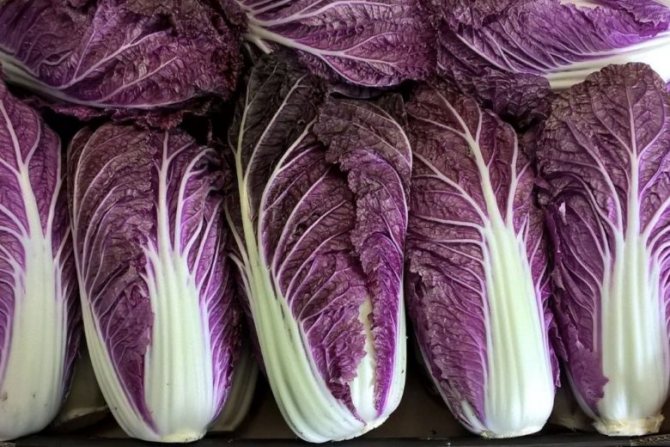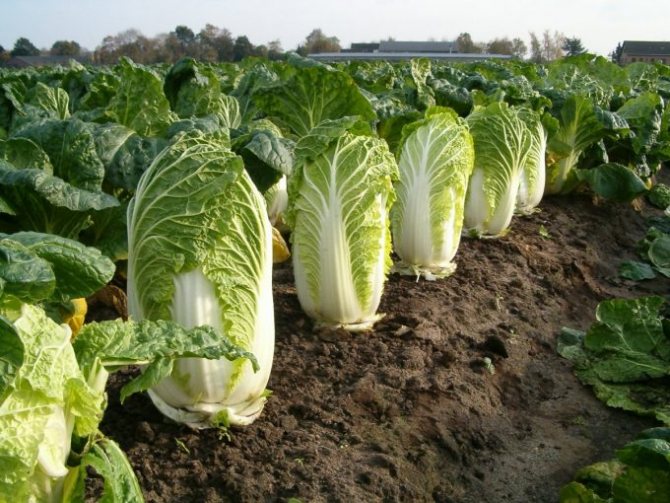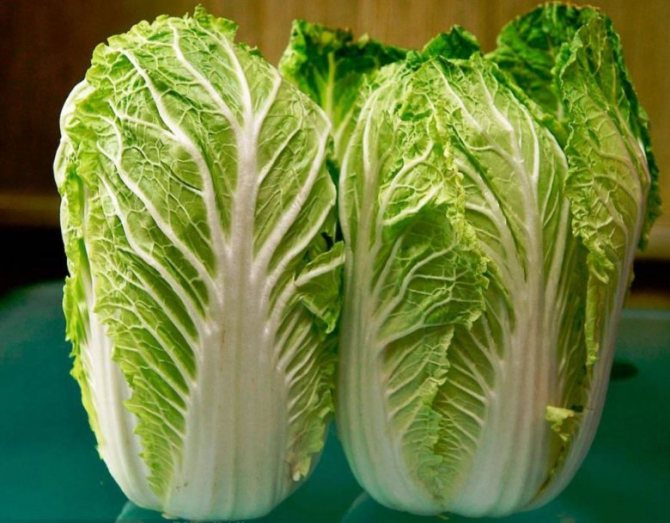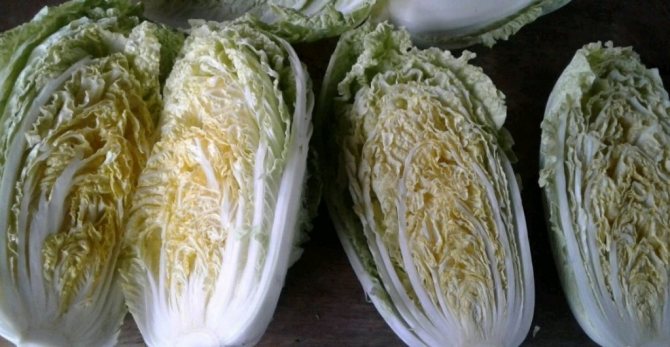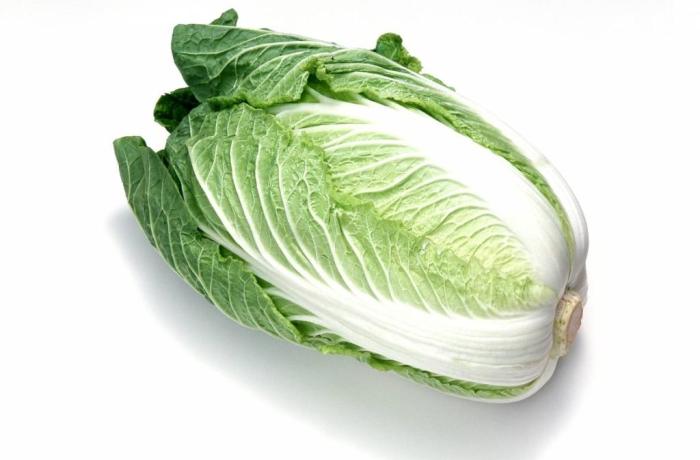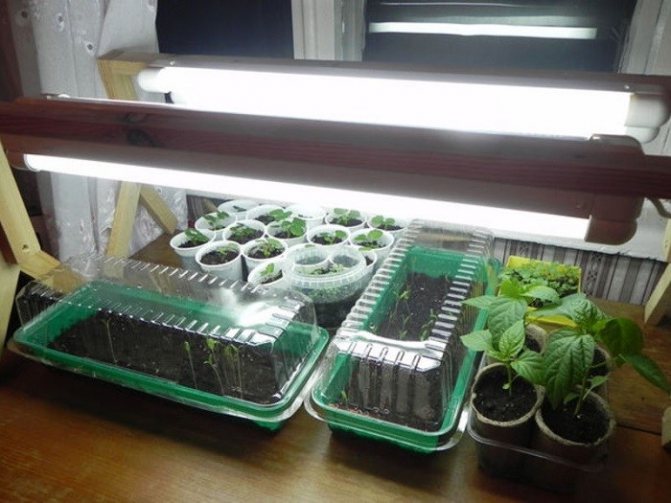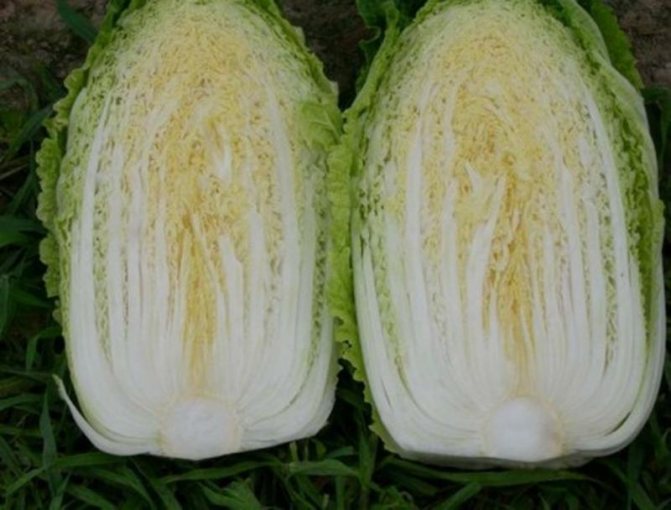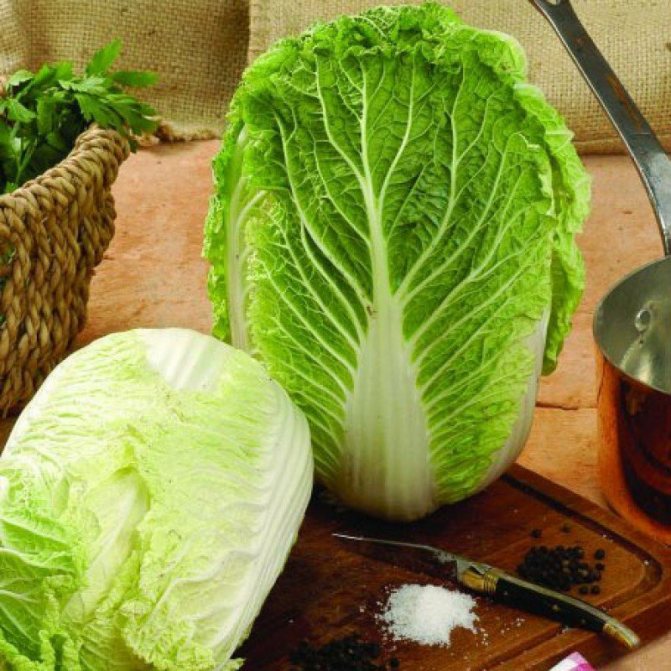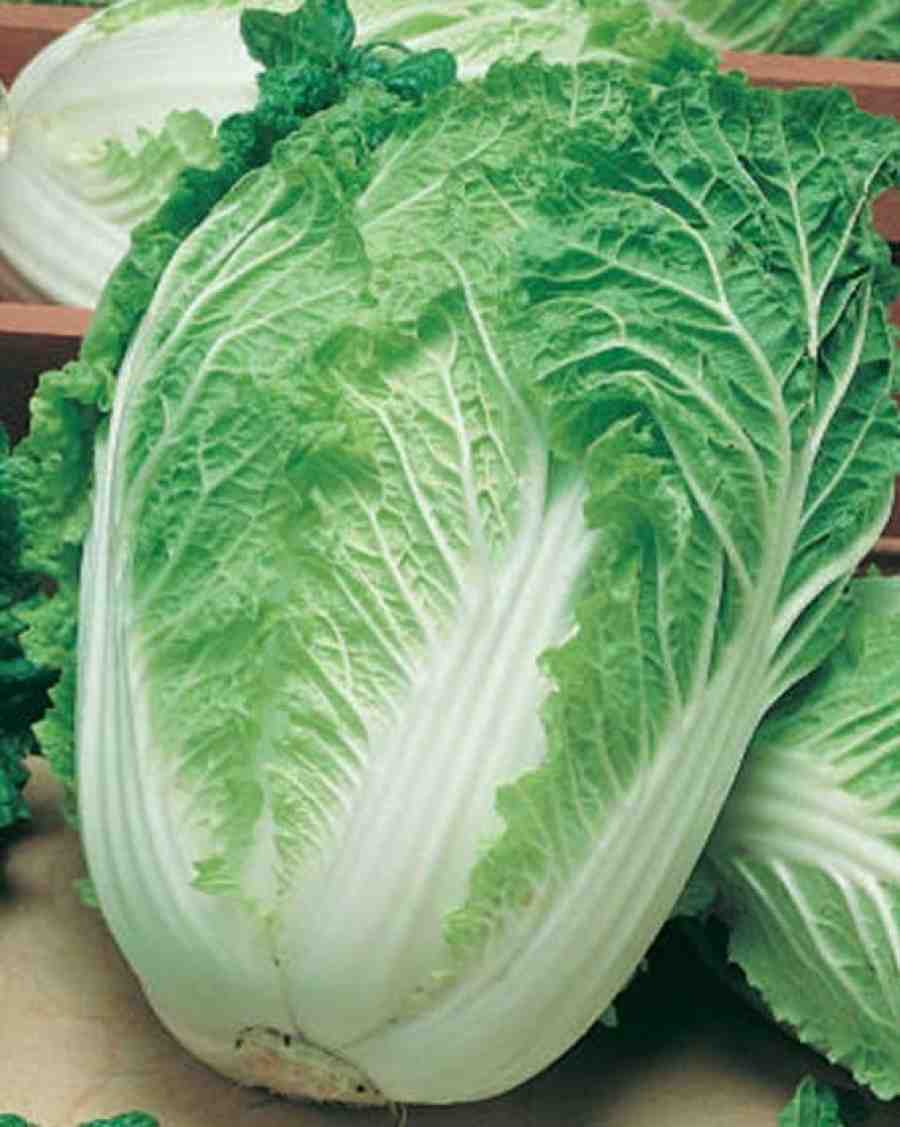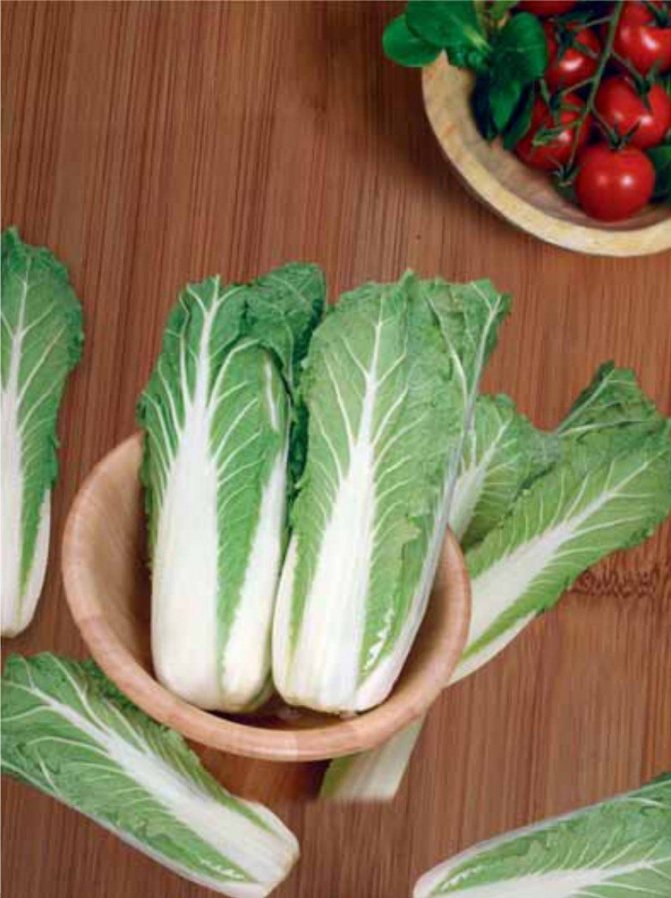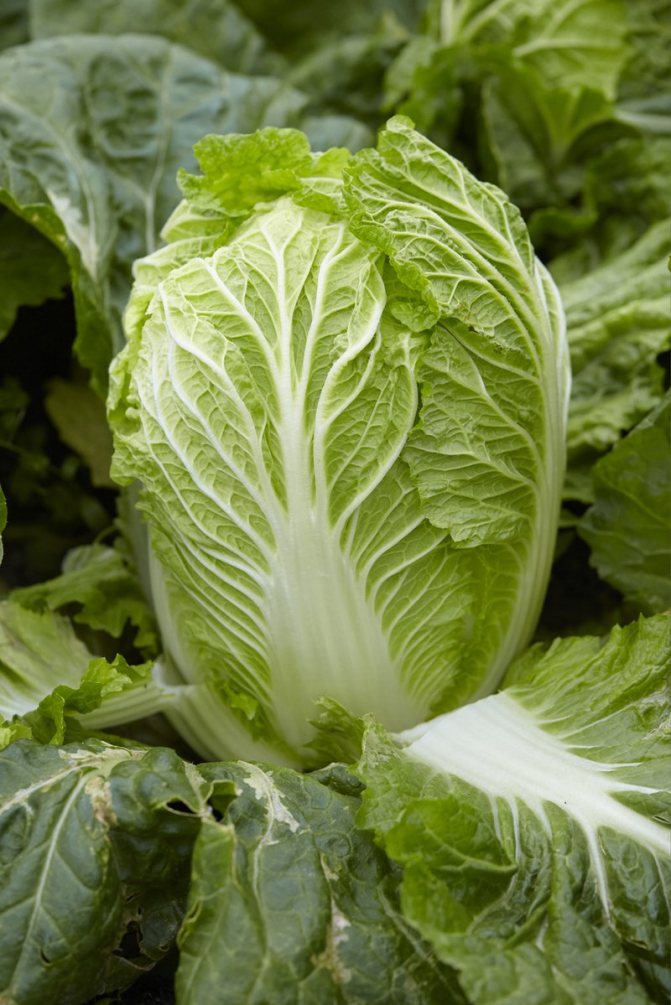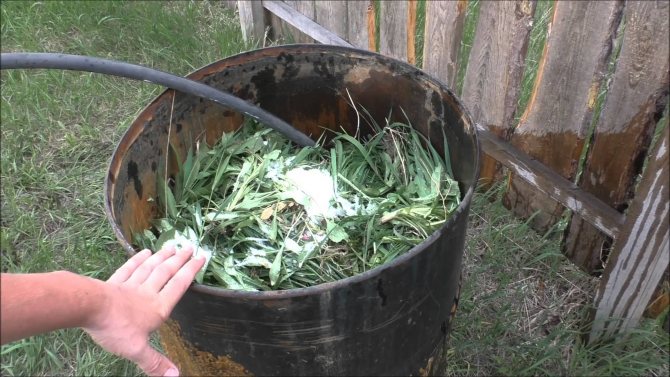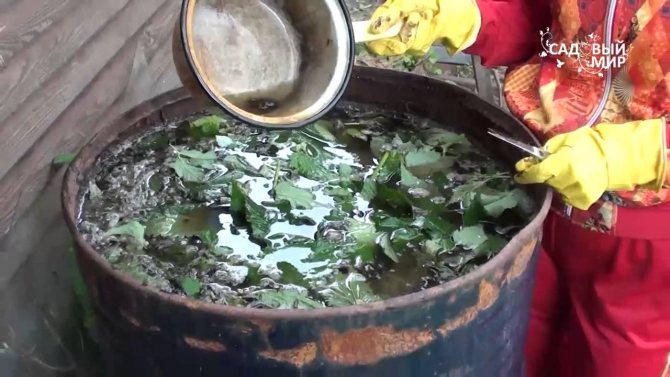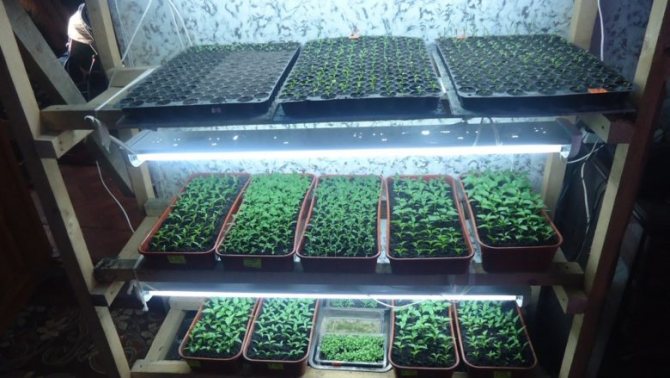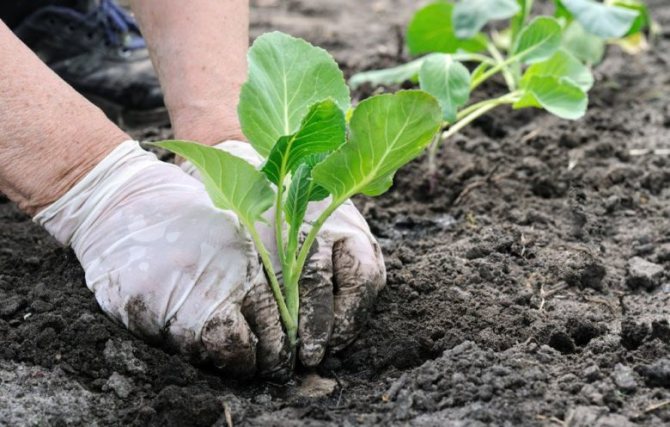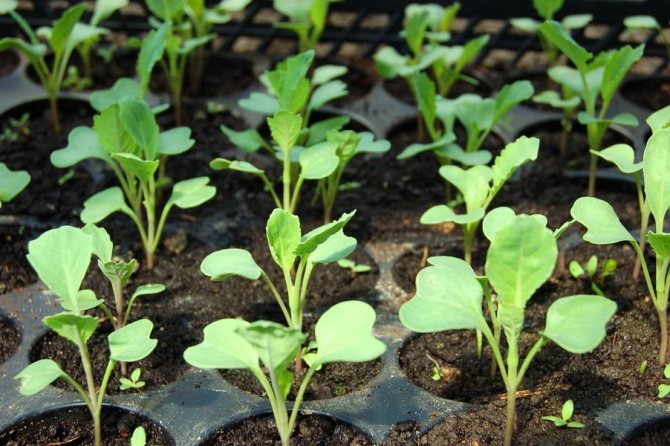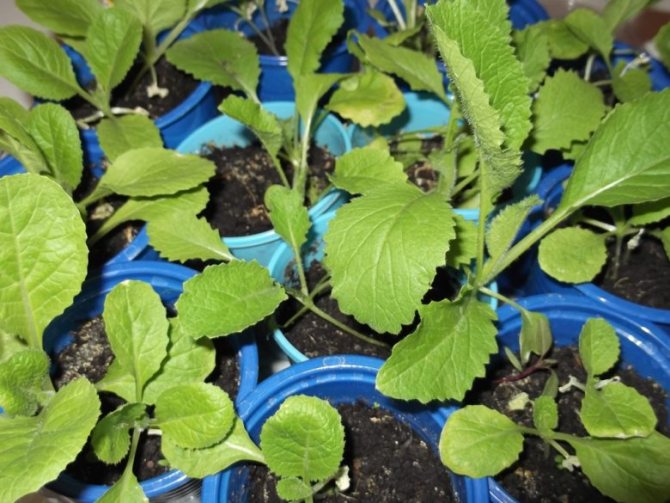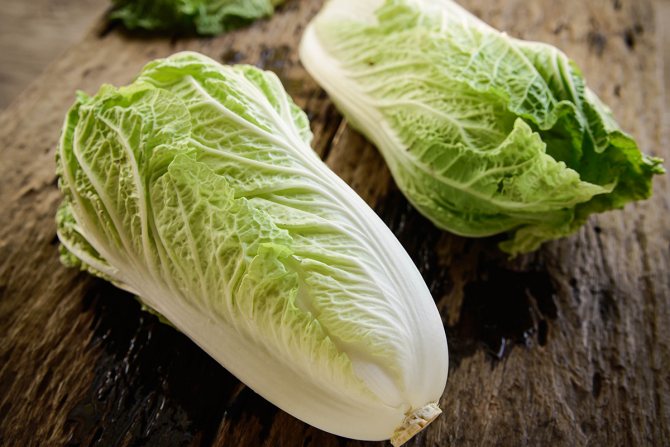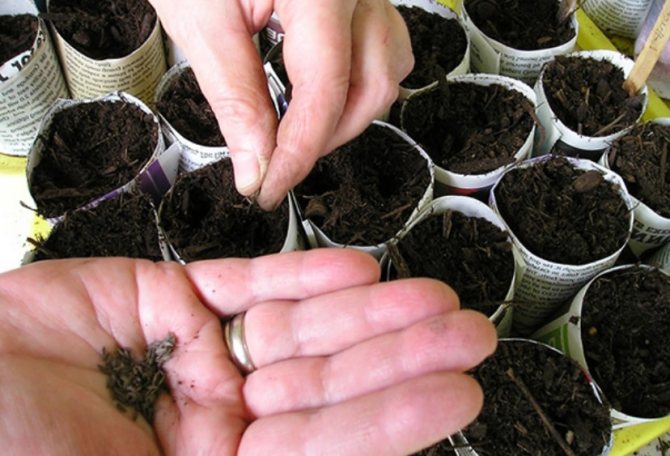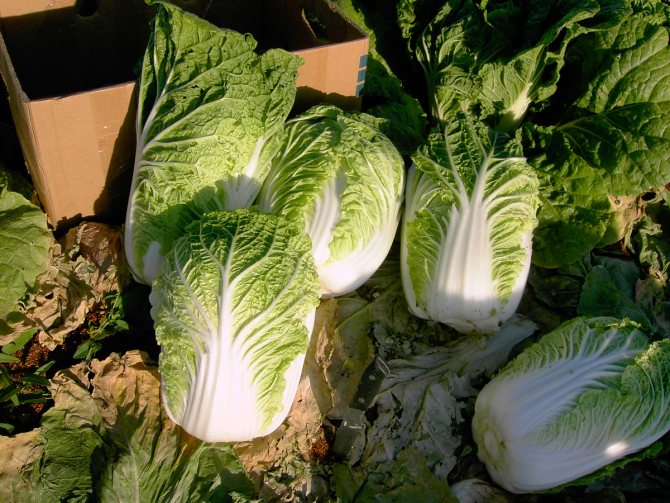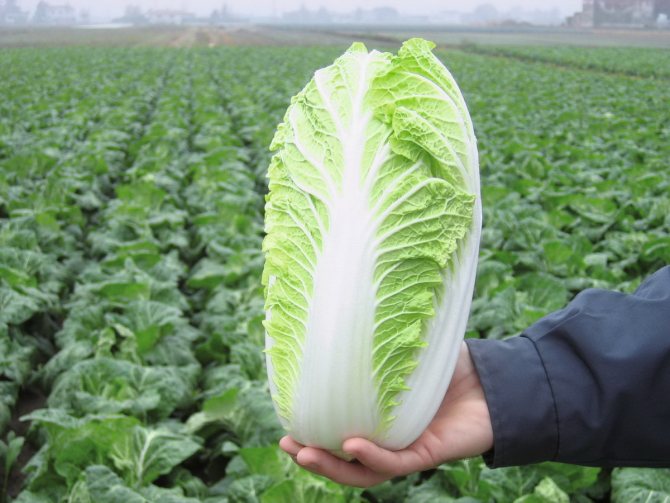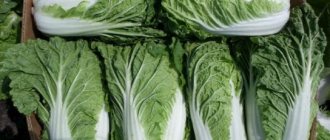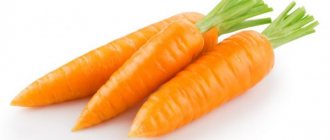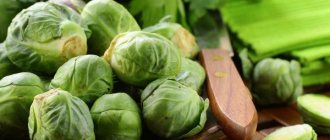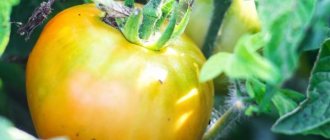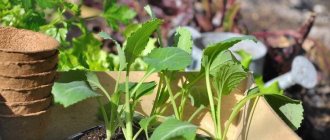When to plant Chinese cabbage for seedlings in 2020 according to the lunar calendar is one of the questions that gardeners ask themselves. There is nothing surprising in this, since it defines auspicious days on the moon for sowing seeds. In addition, there are other ways to determine the optimal timing of planting Peking.

What is Chinese cabbage?
Peking cabbage (Brassica rapa pekinensis) or petsai (English pe-tsai) is a biennial plant. In culture, it is grown as an annual vegetable. Three harvests are obtained per season. This vegetable plant appeared on the Russian market not so long ago - 7-8 years ago. At first, Peking was exotic for Russians, but today it is a popular food product that is in stable demand regardless of the season.
Peking cabbage is an important culinary product. It is distinguished by its valuable nutritional composition, soft structure and juiciness, goes well with meat, fish, vegetables. Peking is included in a variety of dishes - salads, soups, cabbage rolls, etc.
Cabbage ripens in the fall, but grows year-round when grown in a greenhouse. In the warm season, when greenhouses do not spend money on heating, and competitors appear in the form of seasonal vegetables, the price of Peking cabbage falls.
How to grow Chinese cabbage from a stump at home (from a purchased one)
Having bought a head of Peking cabbage in a store, its leaves are usually used, and the stump, as a rule, is thrown away. But do not rush to throw it away, because you can grow a useful plant from it again. And it's pretty simple to do it.
We unpack the purchased head of cabbage from the film in which the head is wrapped.
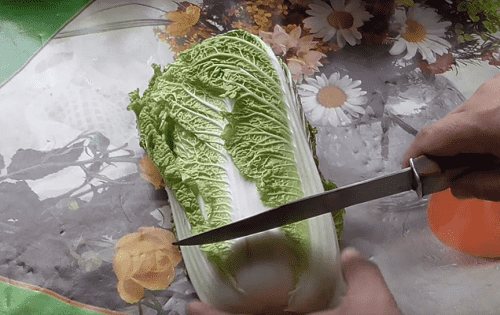

Cut off the upper part from the head of cabbage, the leaves will go for food, leave about 5-7 cm from the bottom.
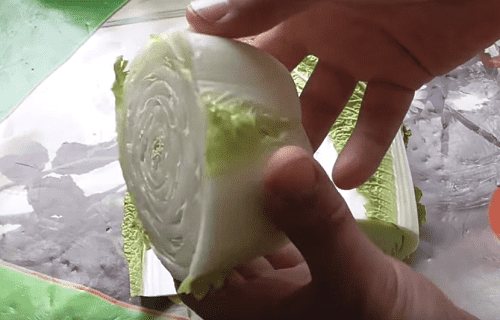

We take a container - a small salad bowl or a deep plate, pour water into it. The water must be standing for a day, or brought from a well.


We place the stump in a salad bowl with water. In the process of growing, add water as needed.


Sometimes in the process of growing the plant blooms, in this case the peduncle is allowed to seed, and the leaves to lettuce.
Botanical description
Leaves - juicy and tender, collected in a head of cabbage or rosette. Color - green or light yellow, depending on the variety. Each leaf has a median vein, the edges are wavy or jagged. The inside of the leaves is pimply. Cylindrical heads of cabbage have oblong leaves. In the context of heads of cabbage yellowish-green, whitish-green, yellowish-white - the color varies.
The main feature and difference of "Peking" from other types of cabbage is the absence of a stump.
Description, features of use
Peking cabbage is an annual vegetable of the cruciferous family. It is also called salad greens. It is grown for the sake of tender juicy leaves, usually green, although there are varieties with a purple tint.
There are three types of Peking cabbage - kale, cabbage and half-cabbage:
- Leafy. Forms only a dense rosette of leaves with a diameter of 30-50 cm, without a head of cabbage. This species is the earliest. The crop is harvested 25–45 days after mass germination.
- Heady. In addition to rosette leaves, it forms an elongated head of cabbage weighing 0.5-3 kg.Ripening period - from 50 to 90 days.
- Semi-cabbage. It looks almost like a headed variety, only the leaves do not fit tightly to the top of the head of cabbage, but expand, that is, the head has an open shape. The growing season is 40-60 days.
Sometimes Chinese cabbage is mistakenly called Chinese cabbage, but they are not the same thing. There are significant differences between them. Chinese cabbage does not form heads of cabbage. Its leaves are smooth, oval in shape, and the petioles are very large, long and sometimes occupy 2/3 of the total volume. In Peking cabbage, the leaves are large, wide and wrinkled, they form the head of cabbage. It has practically no petioles, but there are wide white veins in the center of the leaves.
Peking cabbage is most commonly eaten raw in salads. It is also stewed, fried, added to soups, okroshka, and stuffed cabbage is made. In addition, there are many national dishes, the most popular of which is kimchi. Sometimes Peking cabbage is fermented and pickled, although winter preparations from it rarely work out, since it is too tender for this. It is not recommended to heat it for more than 10 minutes.
In head and half-cabbage, rosette leaves are not eaten, only heads of cabbage are eaten.
Spreading culture
"Beijing" outside the Celestial Empire gradually spread - first, through northern China and the Korean Peninsula, it came to Japan. In the 20th century, Japanese breeders bred many varieties and hybrids of Peking cabbage - they surpassed their predecessors in maturity, yield and taste.
When the "Peking" hit the markets of Europe and America, it caused a real sensation. The great taste of this vegetable quickly won over local consumers, and farmers rushed to grow new cabbage en masse. Peking cabbage has been known in Russia for about 10 years, now this vegetable continues to be actively introduced in domestic vegetable growing.
Useful properties and features of Chinese cabbage
- It contains many vitamins, micro and macro elements, and it also contains organic acids, carotene, sugars, enzymes. Vitamins... B (B1, B2, B6), E, A, PP, K, U, C (here it is 3-4 times more than in a salad);
- Macro and microelements. Selenium, potassium, magnesium, phosphorus, calcium (there is a lot here), iron, zinc, copper, manganese, cobalt, boron, fluorine.
- Lemon acid... Keeps the excellent presentation of cabbage for a long time.
- Lysine... Promotes increased immunity. In Japan and China, this cabbage is believed to promote longevity.
- Orange tangerine, Manoko. These are early maturing varieties.
Benefit, harm and composition
Peking cabbage is prized for its low calorie content. 100 g contains only 14 kcal, which is half as much as in cauliflower and white cabbage. Nutritional value:
- proteins - 31.5%;
- carbohydrates - 64%;
- fat - 5%.


In "Beijing" there is a huge amount of useful substances, among them there are especially many:
- vitamin C - participates in tissue regeneration and accelerates recovery from viral infections;
- vitamins A, E, K, B2, B6, B9;
- mineral salts;
- ascorbic, nicotinic, folic acidt - the latter is especially useful for the body of women;
- trace elements - iodine, zinc, manganese, iron, fluorine, selenium, potassium, calcium;
- lutein - contributes to the preservation of visual function;
- natural sugars - they are safe for the figure;
- fiber - removes toxins and toxins.
Beneficial features:
- improves the work of the cardiovascular system;
- enhances immunity;
- strengthens the nervous system,
- helps to cope with stress and migraine attacks;
- improves the digestive tract;
- promotes the formation of blood cells - prevents anemia;
- lowers cholesterol.
Contraindications:
- pancreatitis;
- increased acidity;
- peptic ulcer.
It is recommended that nursing women consume Chinese cabbage with caution. And in general, this vegetable should be consumed in reasonable quantities. Overeating can lead to stomach upset.
Growing conditions
Peking cabbage is photophilous, but resistant to light shade. It can grow under young apple trees in light partial shade or in those parts of the garden that are poorly lit in the afternoon. It is very important that the daylight hours last no more than 12 hours, otherwise the cabbage will bloom.
It is a cold-hardy culture. It tolerates short-term frosts down to -4–5 ° and can grow at temperatures of 7–8 °, but the optimal conditions for growing it are 15–22 °. If it's too hot, it starts shooting. In prolonged cold weather (below 10 °), it quickly fades into color, and the heads of cabbage are not tied.
Chinese cabbage needs good hydration. It can even be grown in an area with high groundwater. If it does not have enough moisture and at the same time it is hot weather, it goes into the arrow. In addition, insufficient moisture leads to the fact that the cabbage tastes bitter.
The soil should be light and well fertilized. In the fall, phosphorus and potash fertilizers are introduced into it, and nitrogen fertilizers in the spring. It is imperative to add lime to acidic soil in order to avoid keel disease.
Best predecessors
Peking cabbage is recommended to be grown after legumes and grains. The best precursors for "Peking" are crops after which the soil retains a sufficient amount of nutrients.
Favorable predecessors:
- tomato;
- potatoes;
- zucchini;
- cucumbers;
- onion;
- carrot.
It is not recommended to plant Peking cabbage in areas where crops have grown with which it has common pathogens. Unwanted predecessors are other types of cabbage and beets.
The basics and secrets of growing and caring for Chinese cabbage
- Cabbage likes a short daylight hours and an air temperature of + 20-22 ° C.
- Do not plant next to other cruciferous plants. The best predecessors are potatoes, cucumbers, tomatoes, legumes. In the place where Peking used to grow, it is planted again there no earlier than 3 years later.
- It is better to plant by direct sowing into the ground, since cabbage does not tolerate picking well. During transplantation, fragile roots are easily injured, the plant then gets sick for a long time, which affects the yield.
- Don't overdo it with nitrogen fertilizers. If you want to feed, feed the plants with potassium nitrate or an ash solution.
- Protect plantings from pests. Do not use chemical insecticides.Spray the plants with garlic infusion, infusion of potato tops (dilute 1 cup of minced tops in 10 liters of warm water, let it brew for 10 days, strain and spray the cabbage).
- Harvest on time, otherwise, literally in 2-3 days, the head of cabbage will sprout a peduncle. How do you know if a plant is ready for harvest? We check the white-headed one by touching the head of cabbage, if it is strong, tight, then the forks are cut off. It will not work with the Peking one, they look at the bottom. To do this, remove the rosette leaves aside and grab the bottom with your hands. If it is dense and of the desired diameter, the head can be cut off.
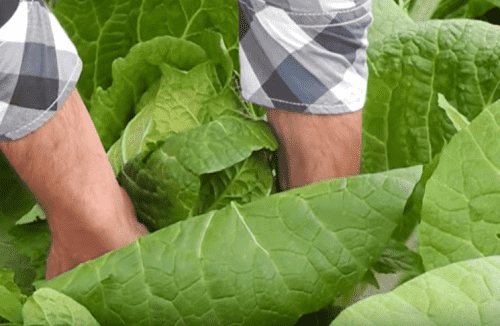

Well, if you missed the moment, and the cabbage bloomed, can it really only be sent to compost? Not at all! The leaves around the peduncle are quite normal and can be used for salad, cabbage rolls or cabbage soup. The only thing is that the leaves are very tender, they are added to borscht or cabbage soup literally before removing the pan from the heat.
Store your crops properly. When harvesting, cut the head of cabbage under the stump, remove the rosette leaves, wrap the head of cabbage with cling film, leaving the top of the head open. Store at 0 + 3 ° C for no more than 3 months.
How to plant Chinese cabbage for seedlings?
Seeds for seedlings begin to be sown 30 days before planting in the ground or in a greenhouse. To get an early harvest, seeds are sown in late March or early April. To obtain seedlings for cabbage, which will be intended for winter consumption, seeds are sown at the end of June.
Preparing seeds for planting
If the seeds are purchased from a seed store, then they do not need special treatment. They do not need pre-sowing treatment, they can be planted directly into the substrate. If home seeds are used for sowing, they must be germinated to identify non-viable seeds.
How to germinate Peking seeds:
- The seeds are laid out between layers of cloth soaked in water.
- Place the seeds in a warm place for germination.
- After 3-4 days, healthy seeds will sprout. Sprouted specimens are planted in containers filled with substrate. Shoots appear in 4-5 days.
Seeds obtained on their own are recommended to be treated with an antifungal composition. The seed is immersed in hot water (50 ° C) for 15 minutes and then immersed in cold water for a couple of minutes. Dry the seeds before planting.
Preparing soil for sowing
Seedlings are grown in loose soil. One of the best options is coconut substrate - it is made from dried and crushed coconut surface residues. On this loose and breathable substrate, it is possible to grow selected seedlings, healthy and strong. It is recommended to mix the substrate with humus in a 2: 1 ratio. To improve the nutritional quality of the substrate, ash is added to it.
The second option for obtaining a loose and nutritious soil mixture for growing seedlings is a sod-peat mixture. The ingredients are mixed in equal parts.
Sowing seeds for seedlings
Peking cabbage does not tolerate any transplant. To avoid picking, seeds are sown not in common containers, but in separate containers. The best option is peat pots or cassettes. Its advantage is the ability to plant in the ground together with seedlings. This approach avoids the stress that accompanies cabbage seedlings when transplanting.
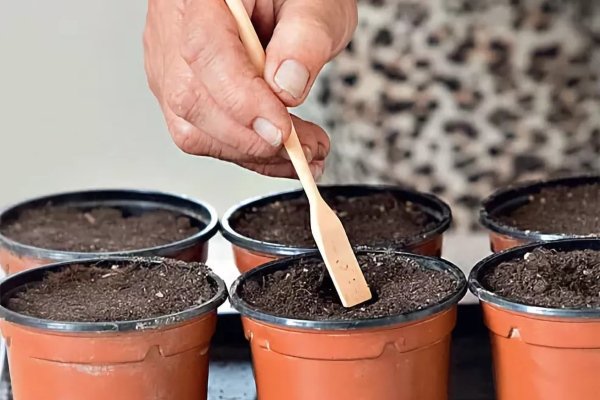

Sowing order:
- 2-3 seeds are planted in each pot to a depth of 0.5-1 cm.
- Watering crops.
- They are placed in a warm place. The crops do not need lighting during this period.
- When shoots appear, the pots are rearranged closer to the light.
Seedling care
Seedlings need a lot of light, the optimum temperature for growth and development is about + 10 ° C.
Care procedure:
- Regular watering. The substrate is moistened as needed. Water for irrigation is used warm, settled.
- Loosening. After watering, the soil is gently loosened.
- Thinning. When the first true leaves appear at the seedlings, the excess plants are removed. There should be one, the strongest and healthiest seedling.
The seedlings are ready for planting when 4-5 real leaves appear on it. This happens about 30 days after sowing. Watering is stopped 3-4 days before disembarking at a permanent place,
Growing Peking through seedlings
Seedling Chinese cabbage is grown only in spring. In summer, it is better to sow directly into open beds. Since the culture does not tolerate transplanting well, and the seedlings die at temperatures above 25 ° C, the seedlings are not grown in the greenhouse (in the ground). To obtain it, separate containers are used, in each of which only one plant is planted.
Soil preparation
When growing seedlings, use a special soil for cabbage or, if possible, prepare it yourself. For this, peat and turf soil are mixed in equal proportions. Then it is disinfected by spilling it with a hot burgundy solution of potassium permanganate. After cooling the soil, fertilizers are applied to it: 2/3 cup of ash and 1 tbsp. l. complex fertilizer (Agricola, Intermag). The primer must be neutral or slightly alkaline.
Sowing seeds
2-3 seeds are sown in each pot, after watering the ground with cold water. When spilled with warm water, and even when kept in a warm room or greenhouse, Peking cabbage initially lays flower shoots, in the future it will not tie a head of cabbage even under favorable conditions. The seeds are sprinkled with earth 2-3 cm. The soil is slightly moistened with a spray bottle.
Seedling care
After emergence, one plant is left in each container. Seedlings are grown at a temperature of 15-20 ° C during the day and at least 10 ° C at night. The shoots are shaded from the bright spring sun. Watering is carried out as the soil dries up, usually every 2-4 days. Water it sparingly so that there is no stagnation of water, otherwise a "black leg" will appear.
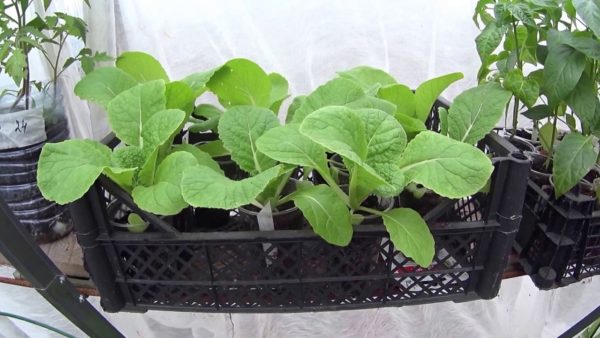

When a "black leg" appears, all containers are spilled with a cold bright pink solution of potassium permanganate. Lying plants are removed.
During the seedling period, Peking is fed once with a complex fertilizer containing a large amount of nitrogen. - Agricola, Baby, Strong.
The timing of planting seedlings of early varieties 15-20 days after germination, medium and late varieties 20-30 days. By the time of planting, the cabbage should have 4-6 well-developed true leaves. It is advisable that the roots do not braid with an earthen lump, otherwise the Peking is difficult to take root and some of the seedlings die. If the roots have already braided a lump, then first, fresh earth is poured into the container so that the roots continue to develop further, and only after 3-4 days the cabbage is planted in the ground.
If it is impossible to add soil, they are planted as it is, without breaking off the roots. In this case, the culture is very difficult to take root.
We plant seedlings in open ground
Planting of seedlings is carried out at sunset or at any time in cloudy weather. They are planted only by transshipment. The holes are made at a distance of 30-40 cm from each other. Make 0.5 cups of ash or 2 tbsp. l. calcium nitrate. The pot is poured with water, and when it is absorbed, the plant is taken out along with a clod of earth, trying not to damage the roots. The seedlings are not buried, the roots are sprinkled with earth and watered abundantly. The next day, do another plentiful watering.


After planting the seedlings, they shade it from the bright sun for several days. Without shading, the plants get severe burns and die.
If the culture does not take root well, then the roots have been damaged, and it is fed with the Kornevin root formation stimulator. Additionally, you can spray on the leaves with Aminosol. It is both a nitrogen fertilizer and a growth stimulator.
If the seedlings are frail and overgrown, then the container is poured with Aminosol solution before planting. This increases the survival rate of plants by 1.5 times. But, despite all the efforts, some specimens will still die. You need to remember this and grow seedlings a little more in order to replace the fallen plants.
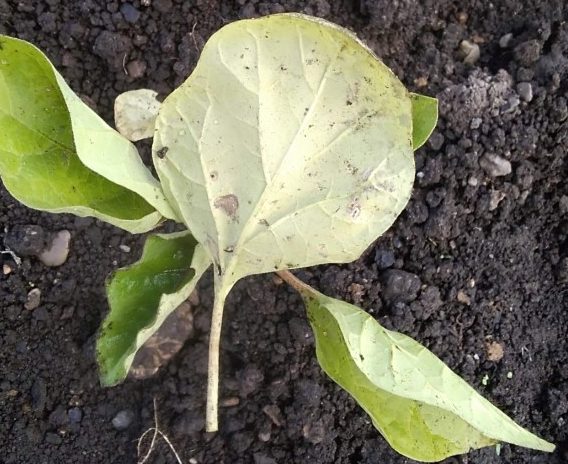

Peking takes 10-15 days, therefore, the survival time is added to the ripening period. The appearance of a new leaf indicates that the seedlings have taken root.
Peking cabbage care
Immediately after planting seedlings or the appearance of 2 true leaves with seedless cultivation, the soil under the crop is covered with spnbond to protect it from cruciferous flea beetles. Mulching the ground with hay for the same purpose is undesirable, since it generates too much heat and the Peking can go into the arrow. Although, when growing hybrids, this option of pest protection is also suitable.
Watering
Water the culture with cold water abundantly and often. In the north, in warm dry weather, once every 2-3 days, in case of rains - once a week. If the rains are prolonged and soak the soil well, then watering is not required.
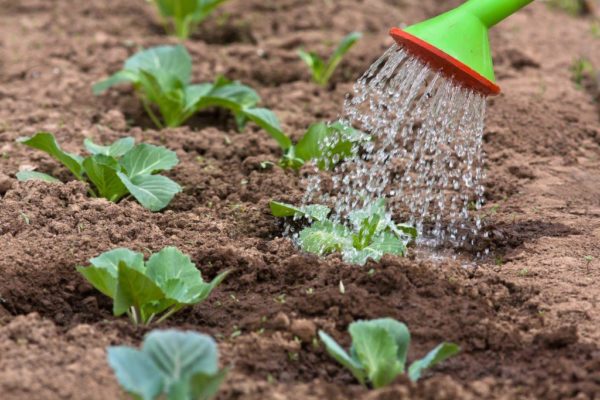

In the south, in extreme heat, it is watered daily. It is watered every day even during heavy rains, since they do not soak the soil. In rainy weather, they are guided by soil moisture. When weeding a plot, they look at the roots of the weeds: if they are wet and the earth is shaken off with difficulty, then watering is not required. But in any case, in the south, in warm and humid weather, cabbage is watered once a week.
Unlike white cabbage, the crop requires a lot of moisture throughout the growing season, including before harvesting.
Loosening
When the land dries up after watering, the plot is loosened, since the culture does not tolerate excessive waterlogging and lack of oxygen in the soil and becomes sick with rot. They are loosened no deeper than 2-4 cm so as not to touch the roots. If the root system is damaged during loosening, the plant dies or stops growing for a long time.
You cannot sprinkle Chinese cabbage.
Top dressing
Top dressing depends on the growing season and the humus content in the soil.
Early varieties Chinese cabbage when grown on fertilized soil is not fed. The only thing they may need in such conditions is soil deoxidation. 20 days after germination or 15 days after planting seedlings on acidic soils, infusion of ash (1 glass per bucket of water) or calcium nitrate (1 tablespoon per 10 liters of water) is added. Neither is required on neutral and alkaline soils.
If the soil is poor, then do one top dressing per season. They are fed either with manure infusion or with complex fertilizers containing microelements (nitrophoska, Malyshok, Agricola).
However, if the Peking stubbornly does not tie the head of cabbage, but gives only leaves, then an infusion of ash or a special complex fertilizer for cabbage with trace elements Omu, Aquarin is added).
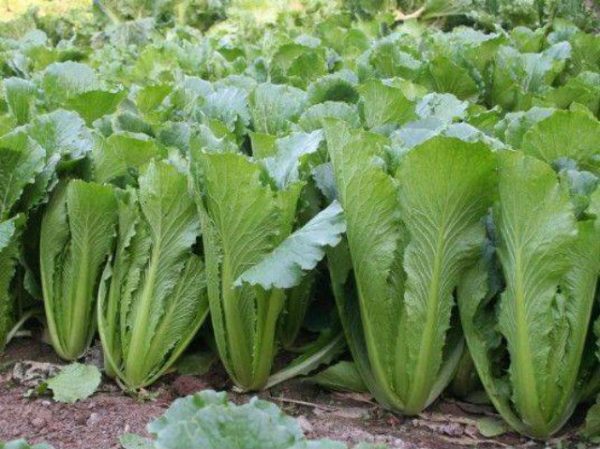

Mid-season varieties feed 1-2 times. With soil cultivation, 20-25 days after germination, an infusion of manure or urea with an infusion of ash is introduced. However, on poor soils, 15 days after the first fertilization, you can feed it again with nitrophos. But top dressing should not be later than 15 days before harvest.
When growing seedlings, the first feeding is done as soon as the cabbage takes root. Urea or ammofoska is introduced. The second feeding is carried out 20 days after the first, using an infusion of ash (1 glass / 10 l of water) and urea 1 tbsp. l per 10 l. It is unacceptable to increase the dose of urea, since nitrates accumulate in the leaves.
Late varieties are fed 3 times, regardless of the cultivation method. The first feeding is done 15 days after the emergence of seedlings or 5-7 days after the seedlings are fully established. Watered under the root with manure infusion (1 glass / bucket).
The second feeding is done 20 days after the first. Ash infusion and nitrogen fertilizers are introduced: urea, ammonium nitrate or weed infusion (not manure!). In the absence of ash, any fertilizer with microelements is used (Agricola, Intermag vegetable garden, Uniflor-micro, etc.). If it is necessary to deoxidize the soil, but there is no ash, then add calcium nitrate 1 tbsp. l. 10 liters of water.
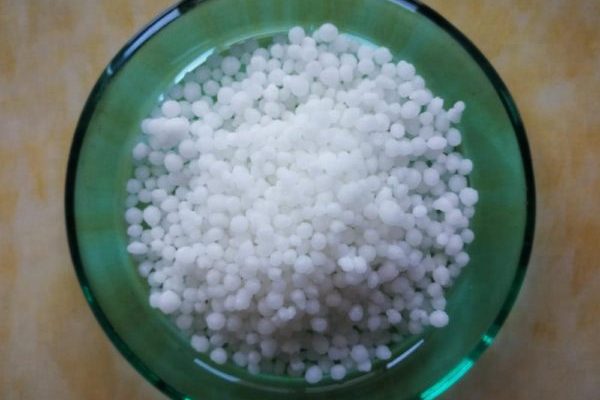

Saltpeter
On acidic soils, after 14 days, the soil is deacidified by pouring milk of lime: 3/4 cup of dolomite flour in a bucket of water. This is not a top dressing and is carried out on acidic soils, regardless of fertilization.
The third top dressing is done 20 days before harvesting. Introduce nitrophosphate, 1 tbsp. l. with a slide on a bucket. You can not apply pure nitrogen fertilizers, manure or weed infusion, since nitrates accumulate in the leaves.
How to transplant Chinese cabbage seedlings into open ground?
If the seedlings are grown in peat pots, then they do not have to be removed - the seedlings are placed in the holes along with the "container". The containers will over time mix with the soil, giving the plants additional nutrition.
8-10 days before the expected disembarkation, the seedlings are hardened - they are taken out into the street. The hardening time gradually increases to one day - after that, the seedlings are planted.
The plot on which the seedlings are to be planted is prepared in advance, in autumn or spring. The soil is dug deeply, removing plant debris. During autumn digging, humus or compost is added.
Seedlings are planted according to several schemes:
- In order for the heads of cabbage to grow large, the seedlings are planted according to the scheme 35x35 cm or 50x50 cm.
- If the cabbage is grown for lettuce leaves, you can use a 30x25 cm pattern.
Disembarkation procedure:
- Before planting seedlings, recesses are prepared corresponding to the root system of the seedlings.
- Superphosphate, urea and wood ash are placed in each well - a tablespoon each.
- The peat pot is carefully placed in the depression and sprinkled with soil.
- The planted plant is watered at the root. Water for irrigation should be warm.
During the first 2 weeks of planting, it is recommended to cover with foil overnight. In the morning, the film is removed.
In order to form high-quality heads of cabbage, the planted seedlings artificially reduce daylight hours.
How an experienced gardener planting Chinese cabbage seedlings in open ground is shown in the video below:
Transplanting seedlings
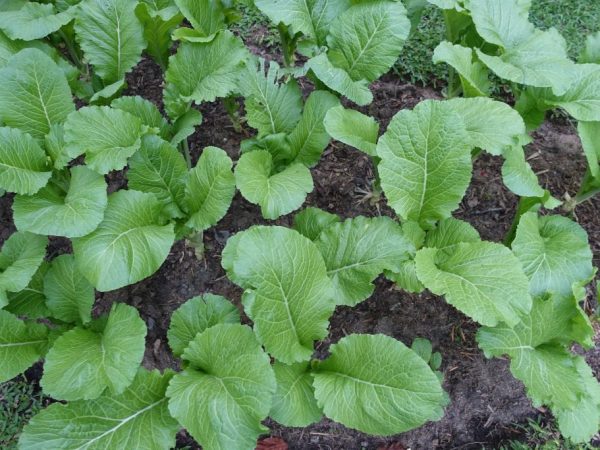

Plants can be replanted when the third pair of leaves appears.
When a stable warmth comes, young plants can be transplanted to the site. The transplantation of young seedlings to the garden bed and their subsequent care is carried out at the stage of the appearance of three pairs of leaves in the shoots.
Soil preparation
It is best for such a culture to choose a site well-lit by the sun. The soil must be prepared in advance:
- she needs a deep digging in the fall;
- the soil is limed;
- in the spring, the site is fertilized with humus (a bucket of fertilizer per 1m2 of soil), then dug up again.
It is best to transplant young seedlings to an area with loose, moisture, breathable and nutritious soil. Before planting seedlings in the garden, the soil must be thoroughly moistened. Loamy soil is best suited for this crop.
It is recommended to plant this crop after:
- carrots;
- onion, garlic;
- cucumbers;
- potatoes;
- green manure plants.
It is not recommended to grow Chinese cabbage after tomatoes and beets. These plants suffer from the same diseases as cabbage.
Transplant
Planting Chinese cabbage in open soil is carried out after ten days of hardening. Young sprouts of Peking cabbage are taken out into the yard every day, increasing the time of its hardening every day.
As soon as the seedlings fully adapt to the outdoor conditions, they are planted on the site. Plants stop watering a few days before transplanting. Abundant watering is carried out before planting the sprouts.
Plants need to be planted at a distance of 20 cm from each other. In this case, the row spacing is 0.5 m.
If the cultivation of Peking cabbage is carried out in order to obtain stubs, the distance between the pits will be 30 cm, the row spacing will be 0.5 m.
We plant seedlings in pre-fertilized pits.In each hole, it is necessary to put 30 g of phosphorus fertilizers, 500 g of wood ash and 15 g of universal fertilizer - urea (urea). Fertilizer is mixed with soil, then watered abundantly. The seedlings, together with a peat tablet, are lowered into the dug hole, added dropwise and slightly trampled.
Growing by seeds
The seedless method avoids the plant transplant step, which simplifies the cultivation of Peking cabbage. Seeds are usually planted in open ground for a late harvest - for the autumn-winter use of heads of cabbage.
Planting dates for Chinese cabbage
The timing of planting Chinese cabbage depends on the climatic characteristics of the regions and weather conditions. Sowing begins as soon as the soil warms up.
When choosing the timing of sowing, the time of the appearance of the first frosts and the ripening of the variety are taken into account. If, for example, the first frosts appear in early September, then the late varieties will not have time to ripen. But in the southern regions, you can easily grow late-ripening varieties.
For direct sowing of seeds into the ground, three seeding times are recommended:
- April 25-May 5;
- May 20-June 1;
- at the beginning of August.
In June and until mid-July, the vegetable is not sown - such plantings develop flowering. The optimum temperature for the development of "Peking" is from +16 to + 22 ° C. Table 2 shows the timing of sowing seeds for different cultivation methods (for regions with a temperate climate).
table 2
| Growing method | Early maturing varieties | Mid-season | Late ripening |
| Seedling | mid-March to mid-April | early April | do not sit |
| Sowing in open ground | May | May | end of July - first decade of August |
| Sowing in greenhouse soil | April | April | mid august |
Planting scheme
When sowing Peking cabbage directly into the ground, accuracy is needed - the seeds are immediately distributed in their holes. The distances between adjacent grooves depend on the variety:
- for early varieties - the interval between adjacent holes is 30-40 cm;
- for late varieties - 45-50 cm.
If the planting for some reason turned out to be too frequent - perhaps the gardener wanted to play it safe and sowed the seeds too often, they will have to be thinned out.
Early-maturing leafy varieties are sown at intervals of 10 cm. When the leaves appear on the plants, they are cut off for salads - space is freed up for other plants.
Sowing seeds in the ground
Sowing procedure in open ground:
- On prepared beds - dug up and fertilized, markings are made in accordance with the planting scheme.
- Sowing can be done in two ways - in the made furrows or in single holes. The best option is to make a small comb, and in it - holes with an interval of 25-30 cm. The seeds are sown into the furrow denser - at a distance of 10 cm. All excess shoots are then removed.
- Several seeds are placed in each hole - 2-3 pieces are enough. Planting depth - 1.5 cm.
- The planted seeds are sprinkled with soil, and slightly compacted with the palm of your hand.
- After a couple of weeks, the seedlings are thinned out, leaving the best sprout.
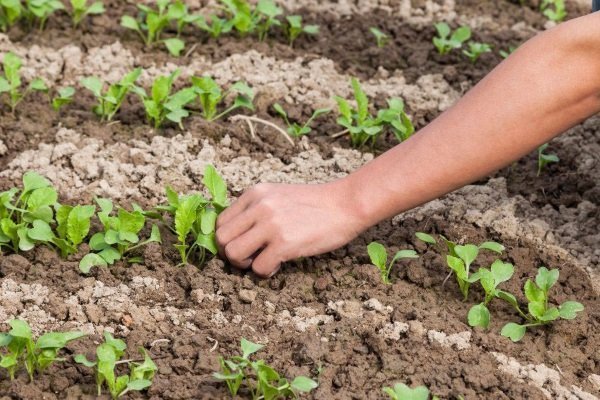

Experienced gardeners advise covering the sprouts with plastic bottles with open lids - so that cabbage, cruciferous flea and slugs do not pounce on tender seedlings.
Planting dates for seedlings
You can grow Chinese cabbage:
- seedlings;
- seed material directly into the open ground.
Before choosing the timing of planting a plant with seeds for seedlings, you need to determine:
- the time of planting the crop in the garden. If you need to harvest the first crop in the summer, then you cannot do without seedlings. In the case when cabbage is needed for the autumn-winter period, then the best option is to sow seeds in July directly into the ground;
- vegetable variety. The timing of planting it for seedlings also depends on this;
- it is necessary to sow so that the seedlings have time to fully form by the transplantation period. In other words, the roots should be strong, and the number of the first leaves should be 4-5;
- in addition, the climate of the region is also important. So, in the northern regions, it is advisable to plant varieties with a short flowering period.
From the moment of sowing seed material to planting them on the garden bed, at least 30 days should pass.
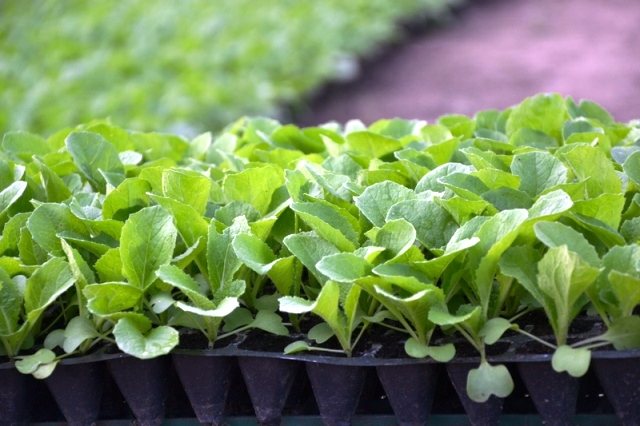

Increasingly, the owners of garden plots are guided by the dates indicated in the lunar calendar.
Planting Chinese cabbage according to the lunar calendar
Taking into account the influence of the moon phases on the speed of seed germination, the activity of sap flow, it is recommended to engage in sowing work only on favorable days for Peking cabbage. At the same time, do not forget about the optimal planting dates for each region. It is necessary to plant Chinese cabbage for seedlings in 2020 according to the lunar calendar in accordance with the table:
| Month | Auspicious days | Bad days |
| March | 1-8, 25-31 | 9-24 |
| April | 1-7, 24-30 | 8-23 |
| May | 1-6, 23-31 | 7-22 |
| July | 22-31 | 1-21 |
| August | 1-2, 20-31 | 3-19 |
| September | 1-2 | 3-30 |
By region
Seedlings are ready for transplanting into open ground 30-40 days after the first shoots appear. But it is also important to take into account the climate of the area where the plant will be grown.
So, planting in the southern regions of Peking cabbage for seedlings in 2020, where early spring, may occur at the end of February and last the entire first spring month. This means that you can "relocate" the culture to open ground in mid or late April.
The weather conditions in central Russia are slightly different - frosts here can return even in late spring. Therefore, sowing seeds for seedlings should not be earlier than April. If there is a greenhouse, then you can grow the crop earlier, only transplant it when the time comes, not in open ground, but in closed one. In the Moscow region and the Moscow region, it is advisable to sow Peking in mid-March, then in the last month of spring it will be possible to plant it on a permanent bed. In the Leningrad Region, these dates are shifted a week later. The ideal period for planting in Siberia and the Urals is late April-early May. But sometimes it's worth waiting until early June.
Caring for cabbage in the garden
In order for Peking cabbage to grow tasty and large, it is important to provide it with everything necessary during its growth - to protect it from adverse natural influences, water and feed on time, save it from diseases and insects.
If the seedling method is used, it is recommended to cover the young plantings with a special cloth - agrofibre or lutrasil.
Benefits of growing under cover:
- The shelter protects the cabbage from both the cold and the scorching sun. Young plants develop well at temperatures from +13 to + 25 ° C, a favorable microclimate is created for them under the canvas.
- Protects roots from rot during rainy season.
- Saves plants from cruciferous fleas.
Half a month after planting the seedlings, the beds are mulched - sprinkled with peat or chopped straw. This agrotechnical technique allows you to retain moisture in the soil and prevents the growth of weeds. Mulching allows you to do without hilling. Loosening is necessary only at the initial stage, when the plants grow up, you can do without loosening.
Watering
A culture needs regular watering for full development. Moisten the cabbage abundantly. The recommended frequency is once a week. For irrigation, warm water is used, it is poured only at the root - water that gets on the leaves causes burns. The best time to water is in the morning or evening, when the sun goes down.
Excessive moisture is unacceptable - it can provoke root rot. The recommended soil moisture is 65%.
Top dressing
Peking cabbage is a fast growing crop, it is very responsive to feeding. Thanks to 2-3 dressings, it is possible to significantly increase the yield. But it is important not to forget - this vegetable quickly absorbs nitrates, therefore, during the growing season, you cannot apply a lot of mineral fertilizers. The frequency of dressings and their composition are shown in table 3.
Table 3
| Top dressing period | Structure | Note |
| 10-14 days after disembarkation of seedlings | Feeding options (per plant - 1 liter of solution): - mullein infusion solution - take 1 kg per bucket of water; - solution of infusion of bird droppings, per bucket of water - 0.5 kg; - infusion of nettle and herbs. | If the culture is planted in spring, then such feeding is carried out three times. Plants planted in summer are fed 2 times. |
| 2 weeks after the first feeding | Complex fertilizer. | Make according to the instructions. |
| 2 weeks after the third feeding | Organic matter is reintroduced. | The rates are the same as for the first feeding. |
To increase yields, in parallel with root dressing, foliar can be used. For example, such a solution is in 1 liter of boiled water, boric acid (2 g) is dissolved. They take hot water, when the acid dissolves, add cold water - enough to make 10 liters. The resulting solution is sprayed with cabbage in the evening.
Fertilizing Chinese cabbage during the period of head formation is described in the following video:
Sowing seeds
- A place is chosen, the soil is dug up in advance and prepared according to the instructions described above.
- Wells are made in it according to the scheme 35 * 35 or 50 * 50 cm.
- 10-15 g of wood ash and 0.5 kg of organic matter (compost or humus) are added to each hole. Everything is mixed well with the soil.
- 2-3 seeds are placed in 1 hole, covered with earth.
- Plantings are watered with warm water and covered with foil.
- Sprouts should appear in a week.
- Leave the most developed sprout, pinch the rest.
For the development of culture, the ideal conditions are considered to be a temperature of 16-22 degrees. If it is higher or lower, flower stalks will begin to form, which will ruin the harvest.
Watch the video! How to sow Peking cabbage
Features of growing in a greenhouse
The advantage of growing Chinese cabbage in a greenhouse is the ability to create optimal conditions for growth. Here it is possible to control the length of daylight hours, temperature and humidity. The best option is a heated greenhouse, where you can grow Peking all year round.
Growing features:
- Peking cabbage can be used to compact tomato and cucumber plantings.
- For greenhouses, it is recommended to use early-maturing hybrids with a ripening period of 40-50 days. The yield of cabbage reaches one ton per hundred square meters. The best hybrids for growing in a greenhouse are Spring Jade F1 and Spring Beauty F1.
- The soil in the greenhouse should be light and fertile. Before sowing seeds, the soil is disinfected - treated with steam or watered with a solution of copper sulfate. This event is especially important if a black leg, keel or other cabbage diseases were noticed in the greenhouse before.
- Sowing in the greenhouse begins at the beginning of March or even earlier. This is if the greenhouse is heated, when using unheated greenhouses, sowing is carried out later - at the end of March.
- Any growing method can be used in greenhouses - direct seeding or seedling.
- Greenhouse maintenance involves regular soil moistening, feeding and thinning.
Variety of varieties
The most popular varieties of Peking cabbage:
- Spring beauty - early ripe hybrid, vegetation period 55–65 days, high marketable qualities, excellent taste, fruitful, consumed fresh, cannot be stored for a long time, forms a closed loose head weighing up to 2 kg, resistant to stemming.
- Princess - an early ripe hybrid, 50-60 days of growing season, is eaten fresh, suitable for short storage, weighing up to 1.5 kg, has an excellent taste and a half-open loose head of cabbage.
- Kudesnitsa is an early ripe hybrid, 50-60 days of growing season, a dense head of cabbage weighing 2-3 kg, has an excellent taste, is eaten fresh, not for long-term storage, resistant to cabbage keel and shooting.
- Nika is a hybrid of a late ripening period, a growing season of 70 days, good both fresh and after culinary processing, resistant to keel and shooting, gives high yields.
- Mojito is a hybrid of medium ripening, used fresh, can be stored for up to 3 months, excellent taste, weight 1.4 kg. Keel resistant;
- Autumn jade is an early hybrid, 55–65 days of growing season, used in home cooking and fresh, excellent taste, head weight 1.5–3.5 kg, resistant to viral mosaic and peronosporosis, high yield.
- Spring is an early ripe variety, vegetation period is 55–65 days, it is used fresh, has excellent taste, is resistant to lack of illumination, low temperatures, and mucous bacteriosis.
- Filippok is an early hybrid, used fresh, suitable for short storage, weighing 1 kg, keel resistant, excellent taste.
- Khibinskaya is an ultra-early ripening semi-cabbage variety, without a pronounced head of cabbage, giving a large leaf rosette on thick white petioles, weighing 2–2.5 kg, for making salads.
Photo gallery: Peking cabbage varieties


Peking cabbage Kudesnitsa is resistant to cabbage keel and shooting
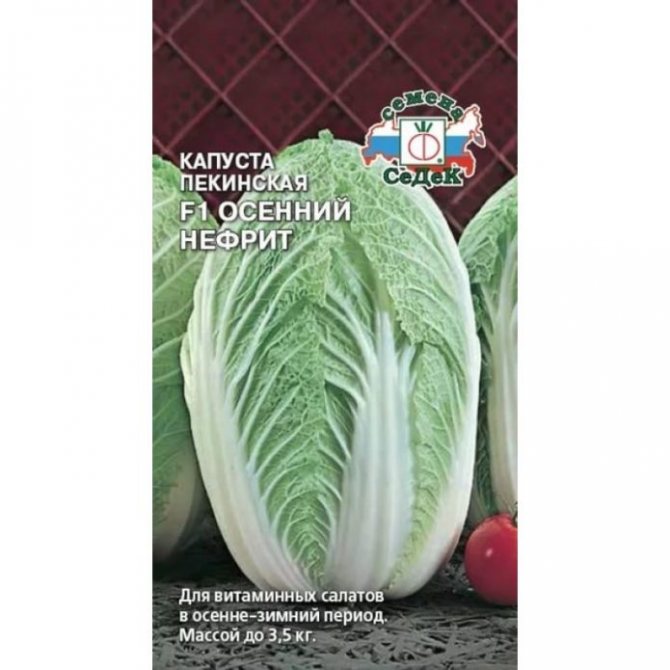

Chinese cabbage Autumn jade yields high yields


Peking cabbage Princess has a half-open, loose head
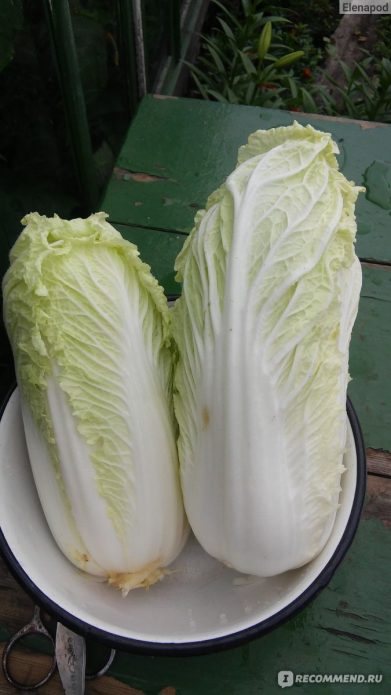

Peking cabbage Spring Beauty is not storageable
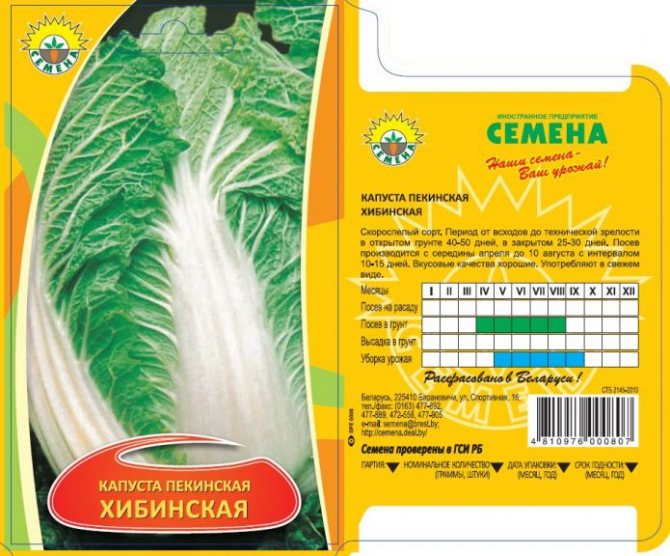

Khibiny cabbage is a semi-cabbage variety, early and fruitful
Diseases and pests
Peking cabbage, due to the short vegetative period, rarely gets sick. But there are plenty of those who want to eat its juicy leaves, these are:
- cruciferous flea;
- aphid;
- slugs;
- caterpillars of a cabbage butterfly;
- cruciferous bug.
To prevent insect attacks, the following preventive measures are used:
- destroy weeds in time;
- seeds are sown on time and the plantings are covered with special canvases;
- observe crop rotation;
- onions, petunias, marigolds and other plants that repel pests are planted nearby;
If the plantings are affected by a cruciferous flea, they are sprinkled with a mixture of ash and tobacco dust, mixed in equal parts. You can also treat cabbage with Fitoverm. If the lesions are strong, apply "Aktara" and other potent insecticides.
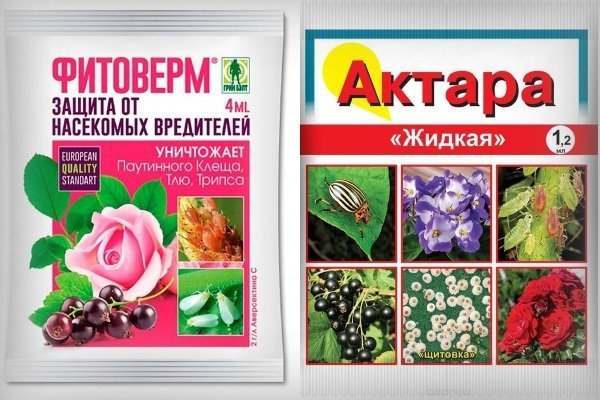

Peking cabbage can be affected by mosaics, keel, white rot, black leg, downy mildew, tracheomycosis. For control and prevention, the following methods are used:
- sprinkled with wood ash - helps against powdery mildew, real and false;
- sprayed with "Binoram" - against bacterial rot;
- pre-sowing seed treatment;
- prevention of waterlogging - to avoid blackleg, if the disease still struck the cabbage, use "Fitosporin" or Bordeaux liquid.
Pest and disease control
Various pests and diseases of vegetable crops not only reduce the yield, but can also completely destroy it. Cabbage especially suffers from them. The most common diseases:
- Keela is a dangerous and intractable disease of all cruciferous plants, caused by a parasitic fungus. She spares neither young nor adult plants. Moving cells with flagella emerging from the fungus reach the cabbage roots, penetrate them and begin their destructive activity. Growths form on the roots, which grow and rot over time. The diseased plant ceases to receive nutrition and dies. Spores of the fungus in the soil retain their viability for up to 6 years, so it is important to observe crop rotation. In case of severe infestation in this area, you should avoid growing cabbage for at least 7 years. A preventive measure against the spread of fungal spores on the site is the disinfection of thoroughly cleaned equipment. The soil where the keel was found is well loosened, drained, and lime if necessary.
- Peronosporosis (downy mildew). With this disease, gray or yellow spots appear on the leaves, a whitish bloom is noticeable on the back of the leaf. Affected leaves wilt and die. Peronosporosis can completely destroy the crop, so you cannot hesitate, at the first signs of a disease, the plants must be treated with fungicides: Fitosporin-M,
- Gamair,
- Alirin-b.
At water temperatures above 50 ° C, the seeds lose their germination, and below 48 ° C, the treatment is ineffective.
Photo gallery: what cabbage is sick with


For the prevention of keela, seeds are disinfected before sowing.
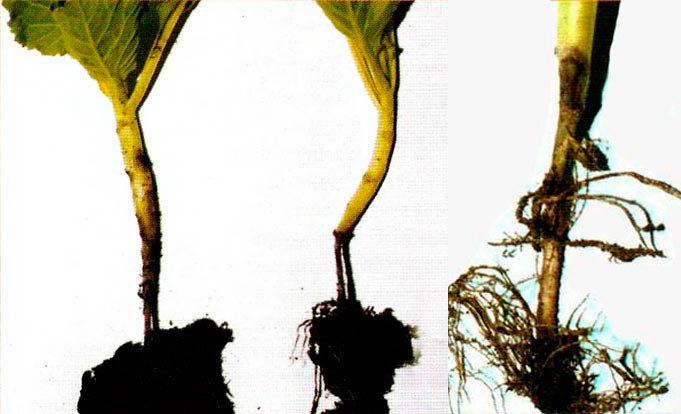

Black leg appears due to excessive watering and in prolonged rainy weather
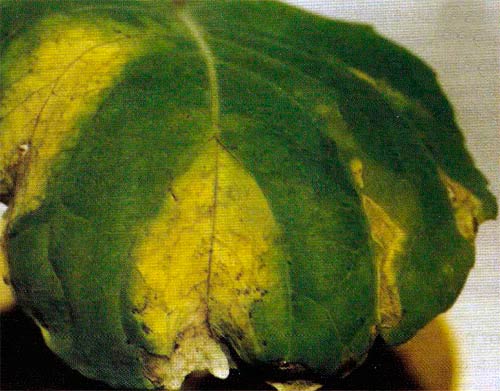

Downy mildew or downy mildew can kill the entire crop
Important! Before using various drugs, be sure to read the instructions!
Peking cabbage pests:
- Mole. A miniature butterfly 1.5 cm in size, a greenish caterpillar and a pupa are all different developmental cycles of the same pest, the cabbage moth. The female moth can lay 80–350 eggs, after 37 days caterpillars will appear from them, which penetrate the leaves, making passages in them. In just 2 weeks the caterpillar turns into a pupa, after another 2 weeks the pupa becomes a butterfly and everything starts all over again. To scare away cabbage moths, you can sow calendula or marigolds next to cabbage. If this did not help and the moth started up, then it is necessary to treat the plants with drugs against pests.
- Cabbage or cruciferous flea beetle is a small bug 2-3 mm in size, sucking juices from cabbage leaves. To prevent the appearance of fleas, plants can be pollinated with tobacco or road dust, and when they appear, they can be treated with approved insecticides.
- Aphids are small, as if covered with whitish dust, sucking insects. They infect cabbage, completely covering the leaves, which subsequently discolor, curl, the development of the head of cabbage is suspended. When a small number of insects appear, cabbage leaves can be wiped off with a cloth dipped in a soap solution, and then sprayed with tobacco broth. If the moment is missed and the aphids have spread, the use of insecticides is allowed.
Photo gallery: who "eats" cabbage


Cabbage moth caterpillars can eat heads of cabbage in a matter of days


The cruciferous flea gives several generations per season, which can completely destroy the crop.
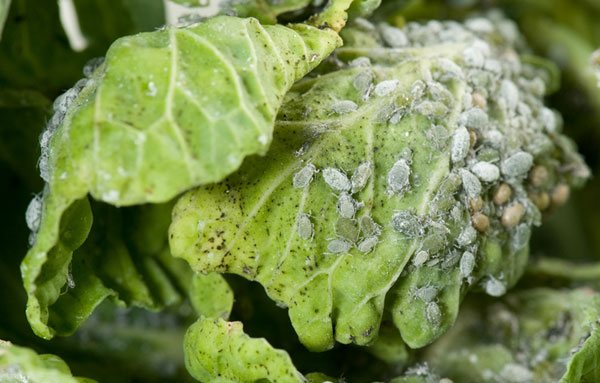

Cabbage aphid infects cabbage by sucking the juice from the leaves.
Since Peking cabbage is an early ripening culture, preparations with a short waiting period are suitable as pest control:
- Decis Profi (deltamethrin). During the growing season, cabbage is sprayed with a working solution (0.3 g / 5 l of water) against cabbage and turnip whites, cabbage scoops, fleas, aphids. The waiting period is 20 days.
- Spark M (malathion), emulsion concentrate.At a concentration of 10 ml / 10 l of water, it is allowed to spray cabbage against a complex of pests. The waiting period is 20 days.
The waiting period indicates how long after spraying the cabbage can be safely eaten.
As an alternative to pest control chemistry, there are several folk remedies:
- Vinegar. Its pungent smell repels many pests. To prepare a solution, 25 ml of vinegar essence is diluted in 10 liters of water.
- Ammonia. All insect pests do not like a specific smell: aphids, flies, bears, whites, slugs. 50 ml of alcohol (1 bottle) is diluted in 10 liters of water.
- A decoction of onion peels with the addition of garlic and laundry soap will scare away aphids. Brew 2 handfuls of onion husks with 1 liter of water, after the broth has cooled, add the chopped head of garlic, 50 g of soap, leave for a day, then strain and bring the volume of liquid to 10 liters.
- To scare away slugs and snails, dust the ground around the cabbage with a mixture of ash, red or black peppers and dry mustard.
Insect treatments are carried out by spraying plants in dry, calm weather.
Even plants love cabbage. One of these parasitic plants is the broomrape. Its roots have changed into suckers, with which it sticks to the cabbage roots, taking away all the nutrients from the cabbage, due to which it exists. Broomrape control measures are reduced to the timely removal of the weed.
Peking cabbage harvest and storage
The collection time and shelf life of Peking cabbage depend on the characteristics of the variety. Heads of cabbage are resistant to cold - they can withstand temperatures up to minus 5 ° С. Therefore, you should not be in a hurry with cleaning.
The varieties planted in the second half of summer ripen in September. Late varieties are harvested in mid-October. Early ripening varieties are not used for winter storage, but cabbage planted in July lays until the New Year.
Collection and storage features:
- Heads of cabbage are harvested before frost. The frozen "Peking" will not be stored.
- Overripe must not be allowed - overgrown heads of cabbage taste worse and are not stored for a long time.
- Do not watered cabbage before harvesting.
- For long-term storage, only fully formed healthy heads of cabbage are laid that do not have rotten or damaged leaves.
- Heads of cabbage are stored in the basement or in the refrigerator. Heads of cabbage are wrapped in plastic wrap or put in bags. Tightness is not needed - a little air must flow to the vegetable.
- Apples and other fruits cannot be stored next to Chinese cabbage.
- To prevent condensation from forming under the film, the heads of cabbage are cooled for 3-4 hours before being placed in the package.
- If you do not pack the cabbages, they will stay no more than 10 days.
- Leaves can be frozen by placing them in bags.
- To store the heads of cabbage in the cellar, they are uprooted. Cabbage is put in boxes filled with moistened sand - sprinkled with roots. Can be stored in bags - they are placed in boxes.
- The temperature in the cellar should be between 0 and + 3 ° C. The optimum humidity is 95%.
- Every two weeks, the heads of cabbage are examined for rotten and dry leaves, and when they are found, they are cut off.
Timing
Sowing time depends on air temperature and weather conditions.
Usually, Chinese cabbage is planted in open ground in 2 stages:
- From April 30 to May 15.
- From June 25th to July 15th.
In the second half of summer, it is better to plant early varieties so that the heads of cabbage have time to ripen before frost. In extreme cases, the harvest is harvested ahead of schedule.
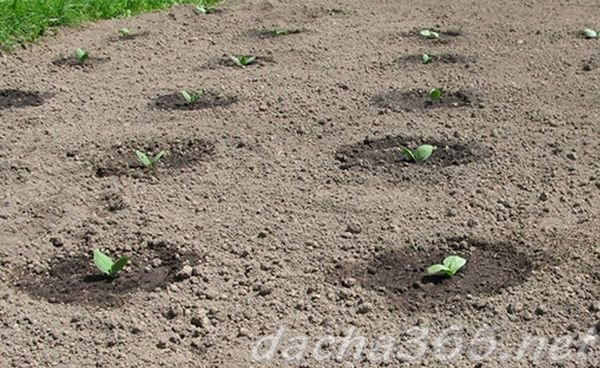

Important! If you plant a crop in the middle of summer, the plants can stretch out and shoot. Such a crop is not suitable for consumption.
Popular bugs
The most common mistakes gardeners make:
- Incorrectly chosen time of sowing seeds leads to flowering. A similar effect is caused by the wrong timing of planting seedlings.Those who doubt the success are advised to use hybrids - their shooting is less developed.
- If the plantings are too dense, the plant does not receive proper nutrition and space for growth - this leads to flowering of part of the crops. To prevent this situation, it is necessary to observe the planting intervals and thin out the plants as needed.
- When the seedlings are transplanted into cold soil, the plants stop growing. As a result, they do not have time to mature, while they often throw out the arrows.
- The intense heat also promotes shooting. If the temperature rises above + 22 ° C, you should not be too lazy to create artificial shading for plantings by throwing a special canvas on them.
- If the cabbage is not removed in time, it will bloom.


Flowering Chinese cabbage
In greenhouse conditions
Consider how to properly grow Peking cabbage in greenhouse conditions. The technology of planting Chinese cabbage in a polycarbonate greenhouse is not much different from the features of planting in the garden. The same scheme and the density of planting are maintained. True, the conditions for growing this crop in a greenhouse are slightly different.
The temperature in the seedling greenhouse should be between 14-19 °. If the temperature rises above normal, the plants will begin to release color. Plants prone to arrowing form loose and tasteless heads of cabbage. In addition, high temperatures can provoke the development of various diseases in plants.
The ideal humidity level in a greenhouse is around 80%.
Peking cabbage is planted in the greenhouse both by seed and seedlings. The optimal time for planting plants in greenhouse conditions is the middle or end of March. You can sow this crop with seeds - in mid-April. The seedling method makes it possible to get a crop a week earlier than the seedling method.
Planting seedlings or seeds is carried out in the same soil as when planting plants on open ground. In the process of growing, cabbage is fed with organic matter and mineral fertilizers containing nitrogenous substances.
Testimonials
★★★★★
Vasily Yegorovich, amateur gardener, Lipetsk region. I grow Peking in a greenhouse. At first I tried to grow it in the usual way - in the open field. But she did not take root well, then the heads of cabbage released arrows and bloomed. Now I grow in a greenhouse - there are no problems with shooting here. I plant different varieties - mostly early ones.
★★★★★
Polina Sh., 45 years old, Krasnodar region. I like Victoria the most. Its heads of cabbage are well stored, moreover, they become even tastier in winter. She has very juicy leaves - perfect for salads. It grows best in a greenhouse, but for me it also ripens well in the open field, the main thing is to cover the seedlings with foil after planting.
Hide
Add your review
There are several important nuances in the cultivation of Chinese cabbage. The main condition for obtaining a harvest is timely sowing of seeds. It is worth confusing the timing, and instead of juicy heads of cabbage, you get a flowering plant. The rest of the "Peking" agricultural technology does not stand out in any way - every gardener can grow this vegetable.
0
Peking cabbage varieties and planting dates
Agricultural technicians consider this culture to be early maturing. All its varieties are divided into:
- early (maturing after 40 days);
- medium (60 days);
- late (ripening period from 70 to 80 days).
Therefore, plant varieties are selected, depending on the timing of the harvest. "Khibinskaya" will quickly sing, "Lyubasha" needs a little more. Gardeners consider the "Cha-cha" or "Pomegranate" varieties to be one of the later types.
Often, even experienced gardeners cannot get a full harvest. Those who are just starting to grow Chinese cabbage are faced with the fact that the plant does not bloom. If he is not satisfied with the intricacies of cultivation or the wrong planting date is chosen, the collection begins ahead of time, the cabbage simply releases arrows.Peduncles can form due to sudden changes in temperature or if the day is too long. Seedlings are recommended to be planted between March and April.
For a later harvest, sowing is carried out in the middle of summer to the first decade of August. The timing can be shifted, depending on the planting method (seedling or non-seedling), the selected variety and climate. Vegetative growth lasts from 55 to 65 days, but no more. Not understanding all the intricacies of growing, gardeners often get the wrong result that they want. This is due to planting in cool weather, when the ground has not yet warmed up or the seeds are sown in late autumn and the heads of cabbage no longer ripen.
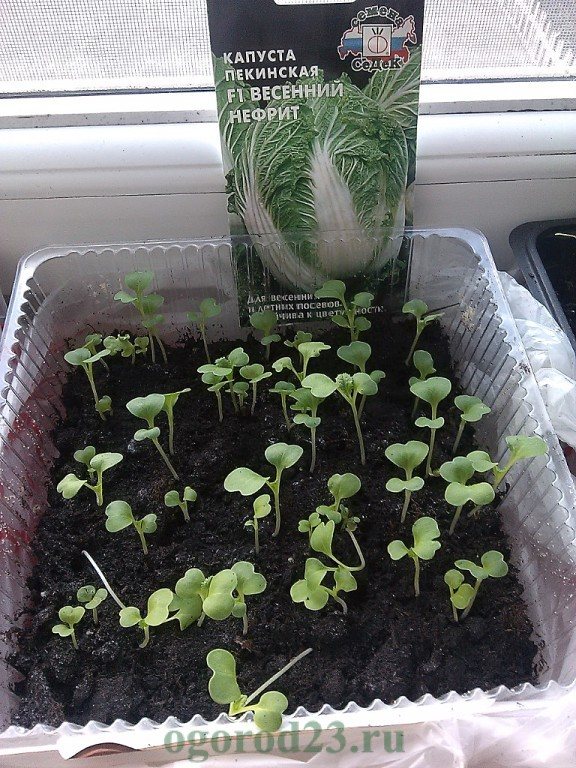

For seedling growing, planting seeds in early spring or mid-July (in the second season) is better. It is best to select varieties that are resistant to flowering. For a sharply continental climate, early maturing types of Peking cabbage are recommended.
This plant is cold-resistant. It is planted in the greenhouse as soon as the snow has melted and the ground has warmed up a little. You can sow seeds in a greenhouse as early as February or March in the southern regions. For more northerly areas, planting in April is recommended. After Beijing, you can plant tomatoes or cucumbers, bell peppers in the greenhouse. To get an early harvest, seedlings can be planted in the last decade of March. To obtain a harvest in winter, seedlings are planted at the end of July.
Further care
Caring for Peking cabbage is easy. For fruitful cultivation, you must follow the rules of agricultural technology:
- ensure timely watering;
- it is good to loosen the soil after rains and watering;
- huddle as the plants grow;
- make top dressing;
- remove weeds;
- protect from pests.
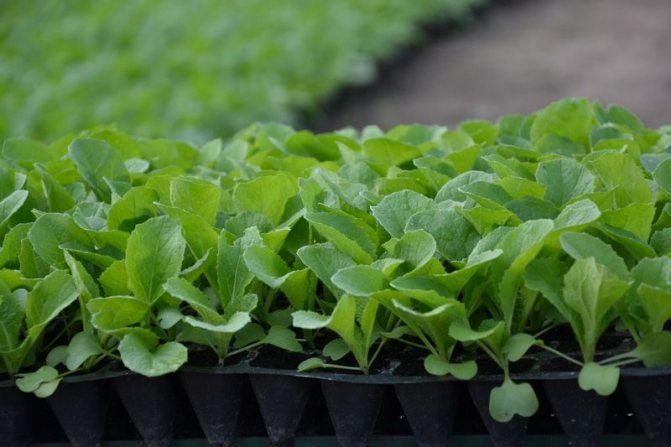

The above activities will help you grow healthy cabbage in large quantities.
Irrigation
For Chinese cabbage, watering is very important, because the volume of the crop depends on it. She needs moderate but regular watering. Excessive moisture contributes to the development of fungal diseases and root decay. It is better to water it with warm water, as cold water shocks it.
To saturate the plants with moisture, in summer cottages, drip irrigation is practiced or Peking cabbage is watered from a watering can. The amount of watering depends on the characteristics of the region and precipitation. Most often, cabbage is watered at least 6-8 times during the entire growing season. Watering is required as the soil dries up and after fertilization.
Expert opinion
Stanislav Pavlovich
Gardener with 17 years of experience and our expert See also Growing and caring for kohlrabi cabbage in the open field
Ask a Question
Peking cabbage is sown again at the end of July, immediately in open ground. Drip irrigation at this stage allows you to fully saturate the plants with moisture and prevent seedlings from washing out.
Fertilizer mode
Timely feeding with microelements contributes to the development of a full-fledged head of cabbage in accordance with varietal characteristics. However, chemical preparations must be used with extreme caution, because the growing period for the development of Peking cabbage most often does not exceed 60 days. Long-acting preparations remain in the leaves for a long time and after harvesting they are eaten.
After planting seedlings in open ground, fertilizing is applied every two weeks. To do this, 1/6 of the bucket is filled with a mullein, into which water is added and left to infuse for 7 days. Instead of mullein, you can make an infusion of chicken droppings.
Formation
Chinese cabbage is easy to care for and does not require heading. Do you need to pick off the lower leaves? Of course yes. However, this operation is carried out under certain conditions: if the leaves are affected by rot or other disease. In other cases, it is enough to break off only the two lowest sheets.
To make the heads of cabbage better tied, many gardeners use boric acid.To do this, dissolve 2 grams of the drug in a liter of cold water and spray the foliage.
Loosening and mulching of beds
Regular loosening of the row spacings allows you to saturate the soil with the oxygen necessary for the plants. Loose soil prevents rot and fungal diseases. The structure of the soil also improves. All these indicators have a positive effect on the health of Peking cabbage and its yield.
Loosens the soil after watering and the rainy season. They do this very carefully, trying not to damage the roots too much. Before the formation of heads of cabbage, Peking cabbage is spud. This stimulates the growth of lateral roots, and the cabbage becomes more resilient. The procedure is repeated two weeks later.
Mulching will help to avoid constant loosening and retain moisture. To do this, use dry grass, sawdust or straw. Overripe manure in the regions of risky farming will protect the autumn Chinese cabbage from premature freezing and saturate the soil with organic matter.
Protection and treatment against diseases and pests
The most common diseases of Peking cabbage are Alternaria and vascular bacteriosis. Weeds are often the vectors of pests and diseases. To prevent weeds, the land is treated with herbicides. For example, "Dual Gold" will save you from exhausting weeding for 1.5 months.
Compliance with the cultivation technology allows you to develop strong immunity in plants and prevent the development of diseases. For additional protection, preventive treatment with fungicides is carried out.
Insects also cause great damage to ripening Peking cabbage:
- cabbage moth;
- aphid;
- slugs;
- cruciferous fleas.
In the early stages of plant development, insecticides can help control pests. In the second half of the growing season, it is better to use folk remedies. These are decoctions of tobacco, onions, soap solution, ash and other options.
How to germinate seeds and grow seedlings
Before sowing, you need to select high-quality seeds. To do this, you need to pour them into a container with water, empty seeds will float, and those suitable for planting will remain at the bottom. You also need to do their disinfection in a weak solution of potassium permanganate.
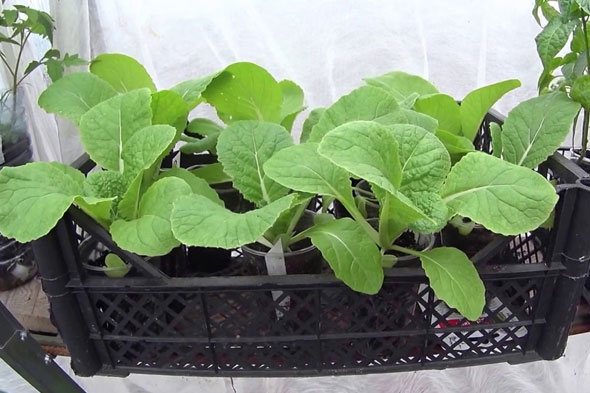

For seedlings, you need to buy ready-made loose soil and decompose it in small containers. Cropped milk cartons, plastic cups, or special seedling pots work well. Additionally, peat tablets can be used, which optimize good growth and protect the seedlings from rotting.
For even sowing, the seeds are mixed with sand and sown to a depth of 1 cm. It is necessary to regulate the illumination. You can not put the plant mainly in the sun, so it will begin to shoot quickly. Daylight hours should be short. Getting the first shoots can be observed after 3-5 days.
When germinating seeds, it is important to carefully monitor the intensity of their growth and promptly remove weak, sluggish plants.
With the appearance of the first shoots, the seedlings can be taken out to the light. It is important to pay attention to the temperature - it should be no higher than 8 degrees Celsius. The soil must be regularly moistened, but not "flooded". The water should be at room temperature. When the plant has 5-6 leaves and it gets strong enough, you can start the procedure for planting in open ground.
Possible problems
Pests
From pests, you can find slugs and cruciferous fleas.
- Slugs can be ward off in several ways:
- bark obstacles;
- baits in the form of beer, citrus fruits, fermented milk products;
- special solutions.
- To combat cruciferous fleas, you can use:
- abundant watering of plants;
- a mixture of ash and tobacco dust in a 1: 1 ratio;
- a mixture of ash and slaked lime in a 1: 1 ratio;
- a mixture of ash and road dust in a 1: 1 ratio.
Diseases
The most common diseases are: keela, black leg, gray mold.


Keela - a disease in which nodules form on the roots of cabbage. As a result, the plant stops developing. Keela is formed at a low pH, so before planting in a permanent place, you need to neutralize it with compost and lime.- Blackleg affects sprouts of Chinese cabbage seedlings. At the same time, blackening and narrowing of the stem is observed, which leads to difficulty in access of nutrients to the leaves, and then to the death of cabbage. To prevent it, you need to disinfect the soil and seeds, take care of the plant.
- Gray mold damages the head of Peking cabbage during ripening or storage. To prevent the disease, it is necessary to spray the plantings with fungicides ("Amistar").
Peking cabbage is a capricious plant to care for, so before growing it is necessary to familiarize yourself with all the nuances, and during it, observe all precautions. But even such difficulties are worth growing such a nutritious plant.
If you find an error, please select a piece of text and press Ctrl + Enter.
Bad days
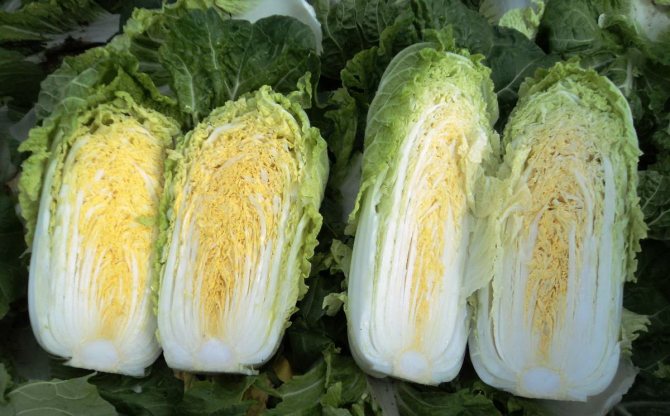

In the event that the gardener determines the date of the beginning of sowing work according to the influence of the Moon on the development of plants, one should not forget about the unfavorable numbers. Depending on the phases in which the satellite of the Earth is, the forbidden days are determined when it is better to leave the plants alone. Vegetable crops are susceptible to disease, they are easily damaged, and injured areas take a long time to recover, the seeds may simply not germinate. The 3 days of the new moon and full moon are considered unfavorable.
Seedlings during this period are also vulnerable. Plants recover for a long time after picking, and when planted on a permanent bed, they do not take root well or get sick for a long time. To be sure of the future harvest, it is better not to carry out any sowing manipulations on unfavorable days.
Table. Prohibited dates
| Month | Day |
| January | 10, 25 |
| February | 9, 23 |
| March | 10, 24 |
| April | 8, 23 |
| May | 7, 22 |
| June | 5, 21 |
| July | 6, 20 |


